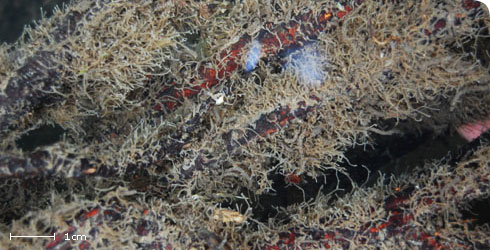Biology
Like all freshwater bryozoan Fredericella sultana forms colonies composed of identical zooids. Each zooid has a crown of feeding tentacles (the lophophore).
Colonies of Fredericella sultana have a tough, chitinous outer wall and are attached to natural and man-made submerged surfaces (Wood and Okamura, 2005). They can resemble plants, as suggested by the common name for bryozoans, the ‘moss animals’.
Size
Colonies can reach sizes of several 100’s of zooids. Zooid length varies with environmental conditions but is usually ~1.5mm.
Growth
Colonies grow by the budding of new zooids. Colonies grow rapidly during spring and form large colonies by summer (Wood, 1973).
Laboratory studies show that increasing temperature and food availability promote prolific growth (Tops et al., 2009, Hartikainen et al., 2009).
Lifecycle
Colonies develop in spring from overwintering dormant stages (statoblasts).
In the UK, dense stands of colonies can be found from May-September. Sexual reproduction is apparently facultative, occurring in early summer. Statoblasts are produced in large numbers in autumn. Adult colonies can survive in a somewhat regressed state through winter in Europe and the UK.
Life expectancy
Colonies are potentially very long-lived as a result of clonal reproduction and survival over winter.
